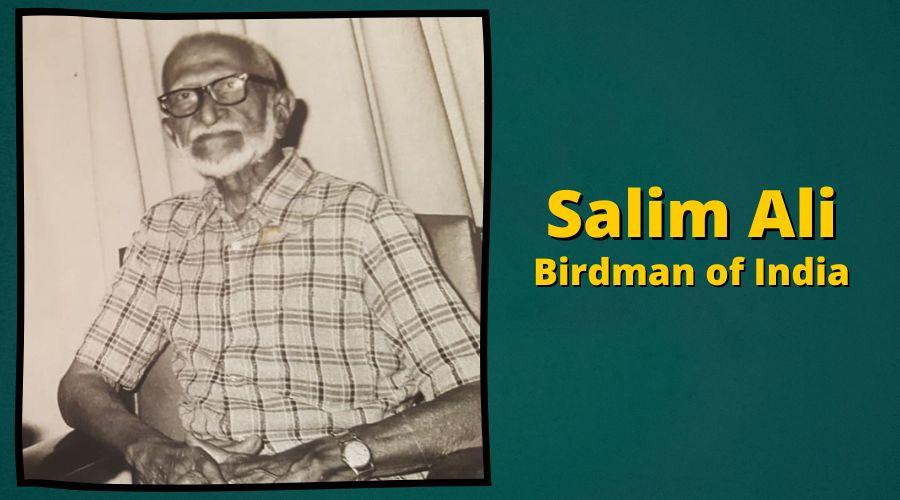Salim Ali- The Birdman of India

Salim Ali, one of the outstanding ornithologists and naturalists of all time, is furthermore recognized as the “birdman of India”. He was one of the very first scientists to conduct organized bird surveys in India and abroad. His research work is considered highly influential in the advancement of ornithology.
Interesting Facts
- At the age of 10, he shot a bird with his toy gun. Unable to identify the bird, he was acquainted with the secretary of the Bombay Natural History Society, WS Millard who offered to educate him in ornithology.
- He also had a curiosity for motorcycles from an early age. He had a Sunbeam, three models of Harley-Davidson bikes, a Douglas, Scott, New Hudson, and a Zenith among multiple others.
- On his 100th birth anniversary, India’s postal department released two postal stamps to regard him. Many species of birds, bird sanctuaries, and institutions have been titled after him.
- Once, he received an award of ₹5 lakh for his contribution to conserving nature. Rather than keeping the money, he donated all the money to the Bombay Natural History Society.
- One of his childhood friends was his distant cousin, Iskandar Mirza, who became the first President of Pakistan. They frequently participated in shooting competitions in their neighborhood.
Early Life of Salim Ali
Salim Moizuddin Abdul Ali was born on 12 November 1896, in Sulaimani Bohra as the youngest of nine kids. His father, Moizuddin died when he was a year old and his mother, Zeenat-un-nissa, expired when he was three. Now orphaned, Salim Ali was raised by an aunt, Hamida Begum and uncle, Amiruddin Tyabji, in Mumbai. As a 10-year-old, Salim once observed a flying bird and shot it down. Gentle at heart, he immediately ran and picked it up. It seemed like a house sparrow, but possessed an odd yellowish shade on the throat. Curious, he showed the bird to his uncle Amiruddin and queried him about the bird’s species.
Unable to reply, his uncle brought him to W.S. Millard, the Honorary Secretary of the Bombay Natural History Society. Surprised at the unique curiosity of the young boy, Millard took him to observe multiple stuffed birds. When Salim eventually saw a bird similar to the child’s bird, he got extremely enthusiastic. After that, the young Salim began exploring the place continually. Salim Ali attended college, but did not obtain any college degree. To help his brother in tungsten mining and timber, he moved to Burma (now Myanmar), but disbursed maximum of his time watching for birds. Shortly, he came back to Bombay.
Contributions and Achievements
As soon as Salim returned, he studied and obtained a degree in zoology from St Xavier’s College. He wedded Tehmina Begum, a distant relative, in December 1918, and got a position of a guide in 1926 at the museum of the Bombay Natural History Society. He instructed the guests and informed them about the preserved birds. His curiosity in the living circumstances of birds thrived even more. Thus, Salim traveled Germany and visited Dr. Irvin Strassman, a world popular ornithologist. He returned to India in 1930 after one year but his position in the museum had been vacated for financial reasons.
Salim Ali needed money to make a living, so he joined the museum as a clerk. The role authorized him to carry on with his bird research. His wife’s house at Kihim, a tiny town near Mumbai, was a serene area encircled by trees, where Salim would spend most of his time surveying about the actions of the weaver bird.
He published a research paper discussing the nature and actions of the weaver bird in 1930. The article made him popular and created his name in the space of ornithology. Salim also wandered from place to place to discover performing bird surveys and making comprehensive observations. Tragically his wife expired in 1939 following minor surgery.
From what he had received, he published “The Book of Indian Birds in 1941” in which he referred to the sorts and habits of Indian birds. The book traded very well for a number of years. He furthermore worked together with S. Dillon Ripley, a world-famous ornithologist which concluded in the ‘Handbook of the Birds of India and Pakistan’ (10 Volume Set); a detailed book wrapping ten years of endeavor from 1964-1974 that interprets the birds of the subcontinent, their appearance, territory, breeding patterns, migration, etc. Salim furthermore jotted down other books encompassing local field guides, “Common Birds” (1967) and his connecting autobiography “The Fall of Sparrow” in 1985.
Later Life and Death
Salim not just surveyed about birds, but furthermore provided to the arena of conservation of nature. For his great endeavors, he has bestowed an international award of INR 5 lacs, he donated all the money to the Bombay Natural History Society. The Government of India praised him with a Padma Bhushan in 1958 and the Padma Vibushan in 1976. This genius man died at the age of 90 o,n June 20, 1987, after a lengthy battle with prostate cancer.